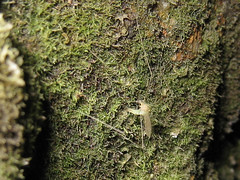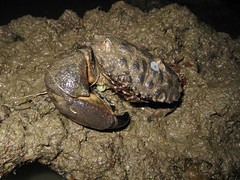Changi with Ria and Dr Dan
 August 14, 2011
August 14, 2011

Early yesterday morning, I had the very unique experience of exploring Changi’s intertidal with Ria Tan, Chay Hoon, and Dr Daniel Rittschof. What fun is walking about the coast when you can go diving you might ask? Well, apart from not having to wash heaps of dive gear afterwards, the shore is a completely new and different environment. Apart from water and sand, I didn’t see anything I would’ve seen if I’d gone diving. (Above: Chay Hoon checks an intertidal pool for critters)

The evening was dominated by crabs. Lots of them. There were Purple climber crabs (Metopograpsus sp.), Stone crabs (Myomenippe hardwicki) tucked into the nooks and crannies and swimming crabs (Family Portunidae) scuttling about in the shallow water. Ria also spotted a Mangrove tree-dwelling crab.

It can be tricky trying to figure out where and what to look out for as the animals in this part of the shore find many different ways to survive the “dry spell” that occurs at every low tide. I was so tickled when Ria pointed out this Rock star aka. Crown sea star (Asterina coronata) huddled next to some bits of sponge in a hole among the rocks.

Chay Hoon pointed out this Blue spotted flatworm (cf Pseudoceros indicus) wrapped around an ascidian, possibly feeding on it. We can also see this critter while diving at Hantu.
As usual, Chay Hoon had to pick out the tiniest of the tiniest nudibranchs. At first glance, these two looked like two of the same species to me, it’s just that one was smaller and the other was even smaller! But Chay Hoon was able to discern that they were probably different. It was only when I returned home to look at the pictures did I realise that they are two quite different! We had to take them out of the water into small containers to be photographed as the incoming surge of water along the shore makes it almost impossible to photograph these tiny beings.

Moments later, Ria found this blob of a nudibranch on the encrusted rock surfaces. I’d never be able to spot something like this!
I always learn so many new things when I’m out with Ria and Chay Hoon. The highlight for me this time were these flowery sea pens! I’d never seen them before! I thought it was a soft coral at first until Dr Dan asked Ria what they were. Seapens usually have gill-like structures extending from the main column, but this one has tentacles that look similar to those we see on corals. Dr Dan spotted the white one and I found this red one afterwards. How fascinating!

As Dr Dan and I wandered off to another lagoon in search of seahorses, Chay Hoon called out that she’d found a frogfish! So I trudged back slowly towards her, trying to stir up as little silt as I could. It’s very different and much slower to move along the shore than to dive along a reef! This Spotted tail frogfish (Lophiocharon trisignatus) was the size of a baby potato and was very active – constantly waddling about the pool of water. They are not good swimmers and move in a very awkward fashion. Ria has a better picture of this fish with its tail flared.

Photograph: Ria Tan
Dr Dan found this Hypselodoris kanga on the side of a rock, making Chay Hoon very excited. It seems like something took a bite out of this nudibranch as its got one mark on its back and another at its gills. Could another nudibranch have attacked it? Did it get into a fight with an angry crab? This beautiful nudibranch has also been spotted while diving at Hantu.
Another curious observation was of the insect life along the intertidal zone! You wouldn’t commonly think of insects when you think of the seashore, but apart from the shore cricket (above left) and the long-legged winged insect that seems to be laying eggs among the algae on the rocks, Ria also managed to photograph other tiny flies, maggots, mites, centipedes and things that look like beetles or cockroaches that were all over the rocks. I wonder if the insects escape up into the dry areas when the tide comes in, or if they have another way of surviving the “wet-spell” just as the sea creatures have ways to survive the low tide.
Dr Dan spotted this sad-looking stone crab that had lost on of its pincers. We were about to walk away when Dr Dan tried to pick it up for a closer look only to realise that it was horribly entangled in a discarded piece of fishing line.

The fishing line was wrapped around all her legs and mouth parts and some had cut so deep it would be impossible to remove the line without breaking her legs. So Dr Dan snipped away what he could so that the crab would be able to moult this old and damaged shell. But a new shell doesn’t mean the crab is safe. With so much debris and discarded fishing equipment along our shores, life on the shore is a never-ending battle.

On the way out, Chay Hoon pointed out this onchidium. It was nice to see them again, the last time I saw them was at Labrador, along the seawall. Here’s something else you don’t see while diving ![]() If you just want to take a break and see some local wildlife, why not trot on down to a seashore near you for a few hours to see what you can find! Thanks again to Ria for letting me tag along for this trip!
If you just want to take a break and see some local wildlife, why not trot on down to a seashore near you for a few hours to see what you can find! Thanks again to Ria for letting me tag along for this trip!
To see more pictures from this trip, visit the Hantu Blog Gallery.








 Posted in
Posted in 



 content rss
content rss
COMMENTS